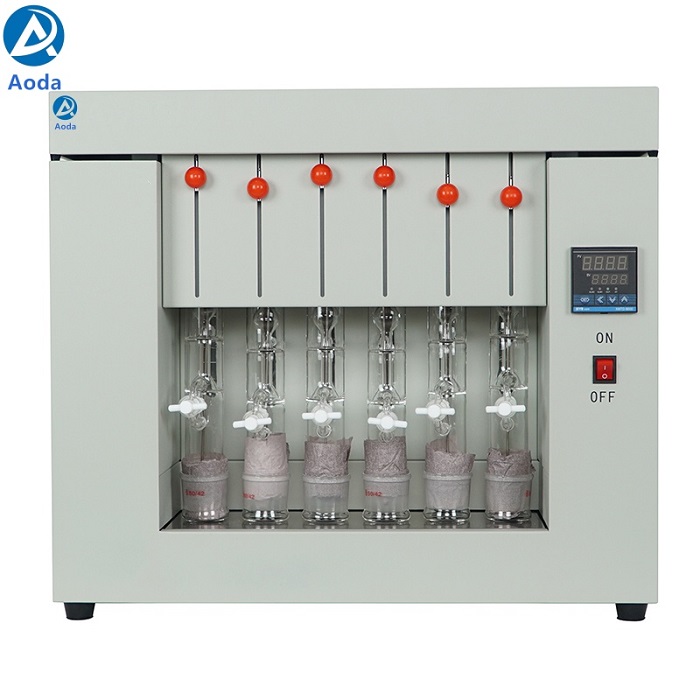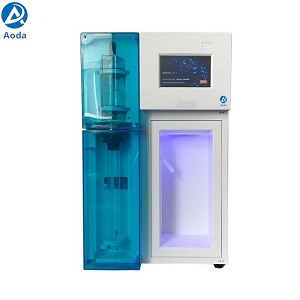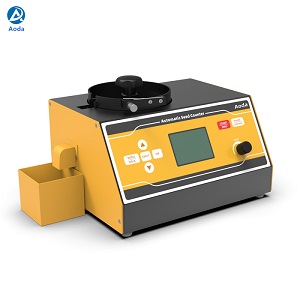
Aoda SZF-06C grain feed food milk crude oil fat content anaysis Soxhlet fat analyzer
The crude fat analyzer is used to determine the crude fat content of samples. It uses the weight determination method based on the Soxhlet extraction principle to determine the crude fat content. It can be widely used in the food, oil, feed and other indu...
- Fast Delievery
- Quality Assurance
- 24/7 Customer Service
Aoda SZF-06C grain feed food milk crude oil fat content anaysis Soxhlet fat analyzer

SZF-06C Soxhlet fat analyzer uses the Soxhlet extraction principle and the weight determination method to determine the fat content of the sample. That is, the fat is dissolved in an organic flux, and the fat is separated from the flux by extraction, and then dried, weighed, and the fat content is calculated.
The Soxhlet fat analyzer is mainly composed of three parts: heating extraction, flux recovery and cooling. It can be widely used in food, oil, feed and other industries to determine the crude fat content.

1. The Soxhlet fat analyzer SZF-06C is small in size, and the water bath heats up quickly and evenly.
2. All parts are ground glass to avoid ether leakage.
3. Digital temperature control, precise temperature control, simple and convenient operation.

Measurement range: grain, feed, oil and various fat products with oil content in the range of 0.5% to 60%
Number of samples to be measured: 6 at the same time
Heating time: within 10 minutes
Recovery system: automatic
Flux recovery rate: ≧80%
Temperature control range: room temperature ~ 100℃
Power supply: AC220V/50Hz
Power: 1000W
Dimensions: 670*250*600mm
Weight: 23kg

| Kjeldahl protein analyzer | Automatic seed counter | Plant chlorophyll meter |
 |  |  |

Q : What is Soxhlet Extraction?
A : Soxhlet extraction is a laboratory technique used for the extraction of compounds from solid materials. It involves the continuous washing of the sample with a solvent, through a cycle of boiling and condensation, enabling efficient extraction of the desired compounds into the solvent.
Q : How Does Soxhlet Extraction Work?
A : The process starts with placing the solid sample in a thimble within the Soxhlet apparatus, which is then placed atop a flask containing the extraction solvent. Upon heating, the solvent vaporizes, condenses in a condenser, and drips onto the sample. The solvent chamber fills until the siphon tube initiates a solvent exchange, allowing the extract to flow back into the flask. This cycle repeats, ensuring thorough extraction.
Q : What Are the Advantages of Soxhlet Extraction?
A : High extraction efficiency through continuous, repeated solvent washing. Suitable for extracting compounds from a small amount of material. Requires minimal monitoring once set up. Can extract compounds with varying solubilities by changing the solvent.
Q : What Are the Disadvantages of Soxhlet Extraction?
A : Time-consuming, often taking hours to complete. Potential degradation of heat-sensitive compounds due to prolonged exposure to heat. Not suitable for volatile compounds due to the risk of evaporation with the solvent.
Q : What Solvents Can Be Used in Soxhlet Extraction?
A : The choice of solvent depends on the compound of interest’s solubility. Common solvents include ethanol, hexane, dichloromethane, and ethyl acetate. The ideal solvent should have a good solubility for the target compound and a boiling point that allows efficient cycling in the Soxhlet apparatus.
Q : Can Soxhlet Extraction Be Used for All Types of Samples?
A : Soxhlet extraction is most effective for solid samples with compounds that are not volatile or sensitive to heat. It is not suitable for volatile organic compounds or thermally unstable substances.
Q : What Is the Typical Duration of a Soxhlet Extraction?
A : The duration of a Soxhlet extraction can vary widely, typically ranging from a few hours to overnight, depending on the compound’s solubility, the solvent used, and the sample matrix.
CONTACT NOW


